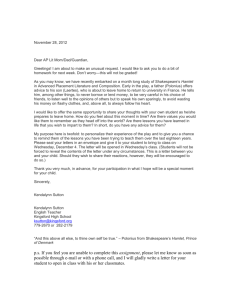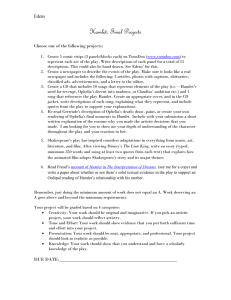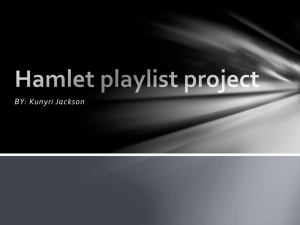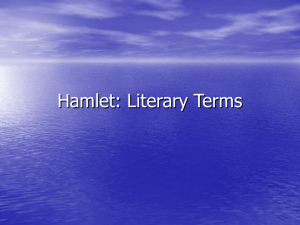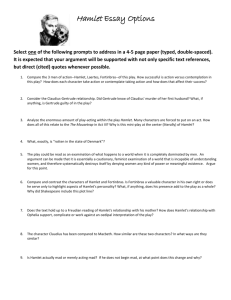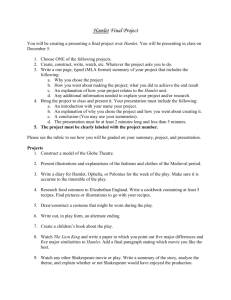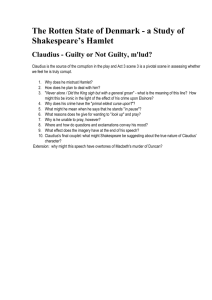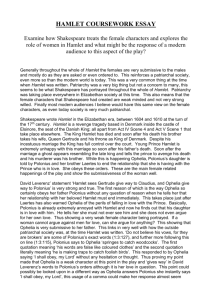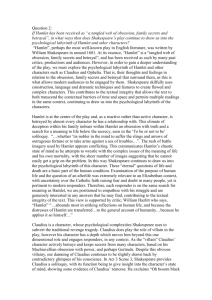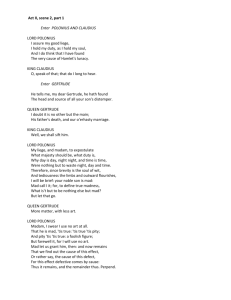Hamlet_intro lecture_transparencies
advertisement
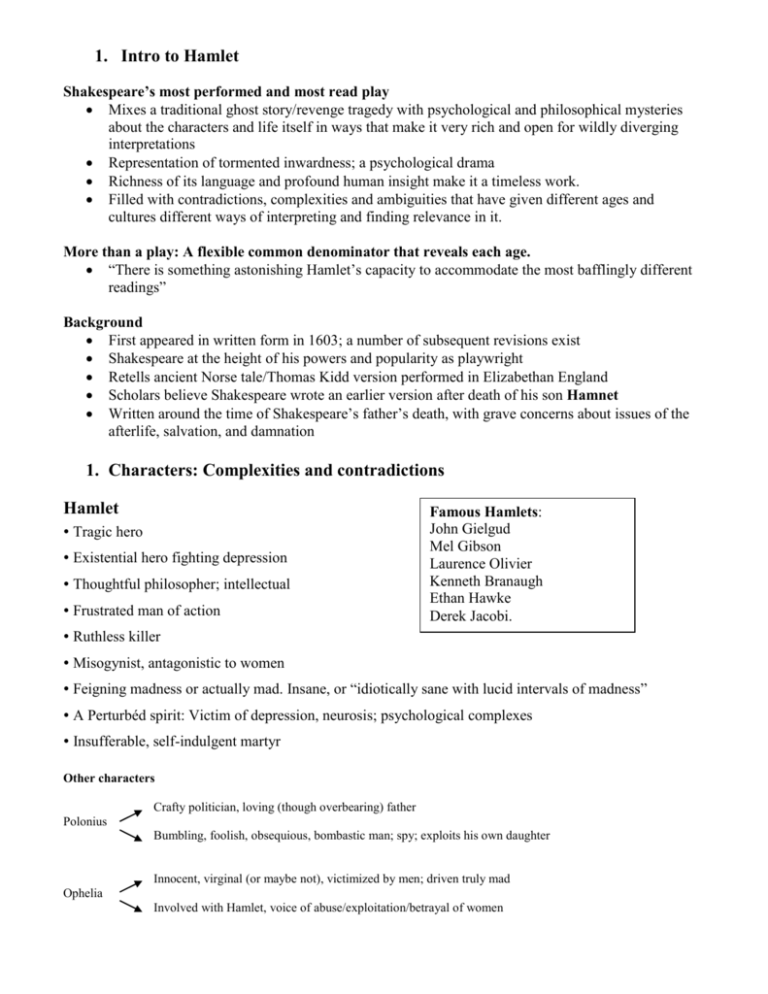
1. Intro to Hamlet Shakespeare’s most performed and most read play Mixes a traditional ghost story/revenge tragedy with psychological and philosophical mysteries about the characters and life itself in ways that make it very rich and open for wildly diverging interpretations Representation of tormented inwardness; a psychological drama Richness of its language and profound human insight make it a timeless work. Filled with contradictions, complexities and ambiguities that have given different ages and cultures different ways of interpreting and finding relevance in it. More than a play: A flexible common denominator that reveals each age. “There is something astonishing Hamlet’s capacity to accommodate the most bafflingly different readings” Background First appeared in written form in 1603; a number of subsequent revisions exist Shakespeare at the height of his powers and popularity as playwright Retells ancient Norse tale/Thomas Kidd version performed in Elizabethan England Scholars believe Shakespeare wrote an earlier version after death of his son Hamnet Written around the time of Shakespeare’s father’s death, with grave concerns about issues of the afterlife, salvation, and damnation 1. Characters: Complexities and contradictions Hamlet ∙ Tragic hero ∙ Existential hero fighting depression ∙ Thoughtful philosopher; intellectual ∙ Frustrated man of action Famous Hamlets: John Gielgud Mel Gibson Laurence Olivier Kenneth Branaugh Ethan Hawke Derek Jacobi. ∙ Ruthless killer ∙ Misogynist, antagonistic to women ∙ Feigning madness or actually mad. Insane, or “idiotically sane with lucid intervals of madness” ∙ A Perturbéd spirit: Victim of depression, neurosis; psychological complexes ∙ Insufferable, self-indulgent martyr Other characters Crafty politician, loving (though overbearing) father Polonius Bumbling, foolish, obsequious, bombastic man; spy; exploits his own daughter Innocent, virginal (or maybe not), victimized by men; driven truly mad Ophelia Involved with Hamlet, voice of abuse/exploitation/betrayal of women Regal queen, mother, wife; loves her son; also victimized by men Gertrude Incest, guilt, complicity Sinful king, ruthless authoritarian dictator Claudius Attempts to rule well; tortured by guilty conscience Hamlet: Key Themes Conflicting Value Systems Medieval Norse Warrior Culture vs. Renaissance Christian Morality “The time is out of joint. O cursed spite That ever I was born to set it right.” (I, v, 210-11) Vengeance, power, betrayal, assassination The “murderous politics of vengeance”; ruthless authoritarian power Spying and Surveillance; secrecy and deception (“Trust no one”) Hamlet→Claudius Claudius, Polonius→Hamlet (using Ophelia and Gertrude as pawns) Polonius→Laertes and Ophelia Ros & Guil→Hamlet Madness, Neurosis, Inner Psychological Disturbance “Though this be madness, yet there is method in ‘t” (II, ii, 223-224) “How does Hamlet? Mad as the sea and the wind” (IV, I, 6-7) Look beyond the oversimplified question of whether Hamlet is insane or not Perturbéd spirits: Hamlet; Claudius, Gertrude, Ophelia Action vs. Intellectualism, Reflection, Internal Turmoil Acting and deception: Seeming vs. Being Deceivers (Hamlet, Claudius, Polonius) and victims (Ophelia, Gertrude, Ros & Guil) Death: “The undiscovered country” Hamlet’s paradoxical fascination with and fear of death and mortality The metaphysical mysteries of death and what comes after (“the undiscovered country”) Issues of salvation vs. damnation The physical realities of death (decomposition, worms, skulls, “quintessence of dust”) Death as the great leveler—renders all, kings and commoners, alike in mortality The play is ominously death-haunted—like Beloved it is set in a middle ground between life and death Fate and Providence “There’s a divinity that shapes our ends, Rough hew them how we will.” (V, ii, 11-12) “The time is out of joint. O cursed spite That ever I was born to set it right.” (I, v, 210-11) Human nature: sublime, sublimely flawed “What a piece of work is man. … Yet to me, what is this quintessence of dust” (II, ii, 327) Misogyny and exploitation/abuse of women Families Unhealthy, dysfunctional parent/child relationships; Oedipal tendencies Loyalty, love, duty, guilt, retribution

